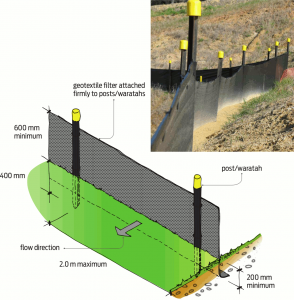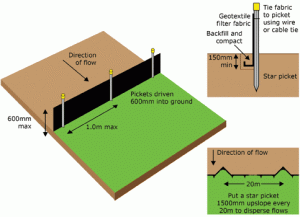Silt Fencing
A Silt fence is widely used for sedimentation control from multiple work sites to protect nearby waterways, drains and community areas especially the case after storm activity. The product is cost-effective and installation can be fairly simple. The fence is used to contain sediment/silt while allowing otherwise clean water to pass through unobstructed leaving silt attached to the fence.
Siltforce silt fences are installed manually, with quality trade people at minimal expense. Silt barriers should form an important part of any strategy for silt, sediment or erosion management along with silt basins, sausages, filters or traps.
Correct placement and ongoing maintenance and removal when the task is complete is critical. The positioning of a silt fence should be downslope of any main area of construction or works activity. In regard to sediment, disturbance placement will determine whether it is an effective tool for sedimentation control. The silt fence should be positioned so that it creates runoff, allowing for sedimentation.
If the silt fence is a D.I.Y project we recommend that the best practice ensures the height is maintained at a minimum of 500mm above ground and a maximum of 800m. Stakes should be installed at 2-meter intervals on the water flow out side of the barrier. You should also create the foot trench and ensure the membrane is inside the soil the lower edge of the fence in the soil, and backfill as necessary.
Ongoing Maintenance
We recommend ongoing maintenance based on weather conditions over intervals that suit the works site needs. However, it is important that the silt fences are manually inspected after storm activity or after particularly heavy usage. When this occurs you should ensure the fence is cleaned or sections replaced as required. In the event that the silt fence does require sections to be replaced, it means it is capturing all sediment before it enters the stormwater network; so it works.
A Silt Fence needs to be installed properly in order to work effectively. If you’re not sure what to do contact Siltforce on the website communication tab. The silt fence should be cut into the ground, not laid on top. It should be staked (using quality star pickets) every 2 meters. Heavy build up areas could require more stakes, and also in some cases a double barrier. A Silt Fence is commonly used in conjunction with other products and biodegradable erosion matting, and other principle erosion control products. These products are used together to create a system that’s manageable and won’t build up the load on one product or perimeter barrier creating serious damage and more problems.
Siltforce never compromises on quality of the material we use, this allows for longevity and performance of the silt fence and sediment control on that site. Revegetation is only going to occur with nurturing and management.

